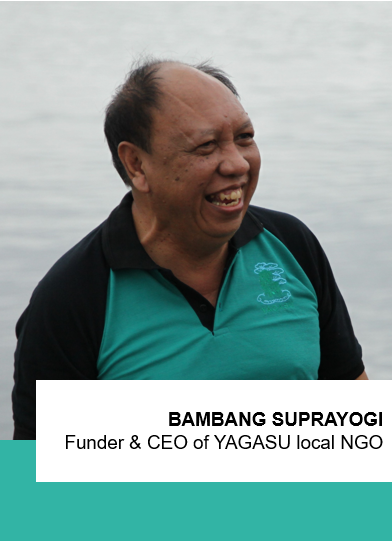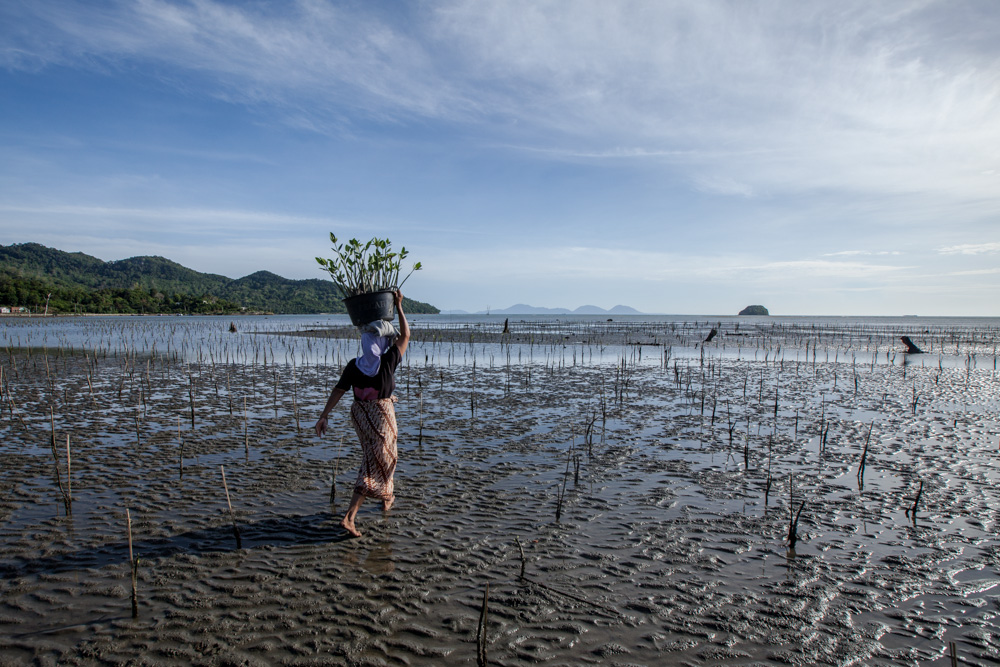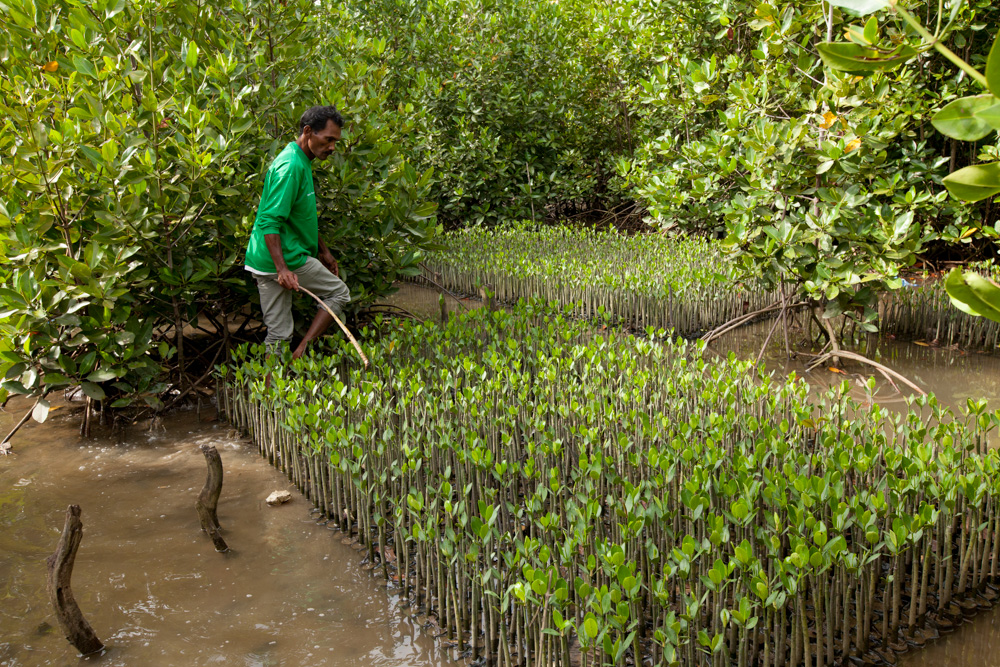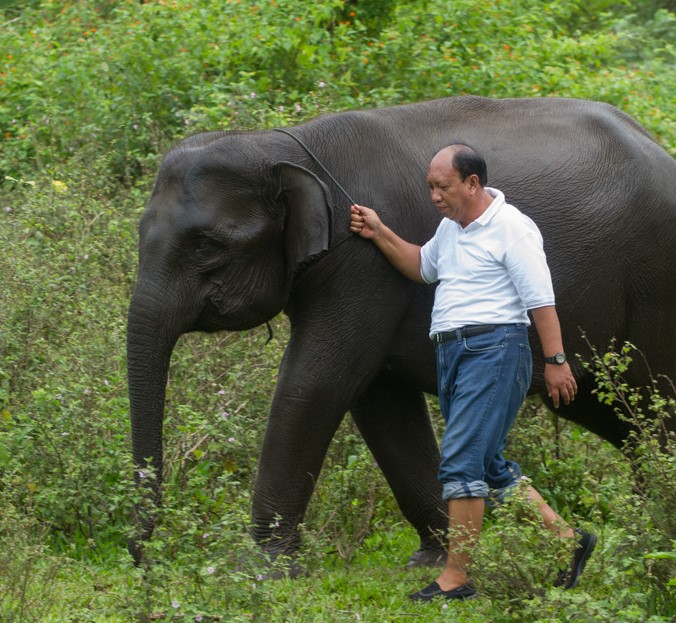Did you know that mangrove belts of several hundred meters wide could significantly reduce the flow of a tsunami? [1] In 2004, the tsunami that hit the coastal regions of Aceh and North Sumatra provinces in Sumatra island, Indonesia, took away 220,000 lives. The region’s mangrove forests had been highly deforested, mainly due to intensive agricultural practices leading to convert forests into croplands. In 2011, the upfront financing of the Livelihoods Carbon Fund helped Yagasu Indonesian NGO restore 5,000 hectares of mangroves to protect the coastline. In 2018, Livelihoods renewed its support to finance the restoration of 5,500 additional hectares with a strong focus on developing economic opportunities for the local communities.
Founder and CEO of Yagasu local NGO since its launch in 2001, Bambang Suprayogi has a rich scientific background and strong vision on how to couple mangroves sustainability with income generating activities for the coastal inhabitants. How did the Livelihoods Carbon Fund model help couple mangrove restoration with improved livelihoods for the local communities? Why is now the right moment to bring a resilient model that has proved to be efficient, at global level? Bambang Suprayogi shares his vews.

Livelihoods: What has been achieved within the Livelihoods-Yagasu project in the coastal areas of Aceh and North Sumatra?
Bambang Suprayogi: « What we have achieved together with Livelihoods is the restoration of an ecosystem of mangroves that had been fully destroyed in the past. The devastating effects of the 2004 tsunami showed us that mangrove forests played a key role in protecting the coastal areas and its inhabitants. Between 2011 and 2014, we planted 18 million mangroves on 5,000 hectares to rebuild a natural mangrove barrier, that is essential to maintain life in these fragile areas. In 2018, a new carbon project financed by Livelihoods investors is helping us restore 5,500 additional hectares of mangroves and sequester 2.5 million tons of carbon over 20 years! Both projects will represent a total area of 1,824 kilometres that are vital for the local populations.”
Livelihoods: What would you answer if you were being told that carbon offsets have no impact for the local populations?
Bambang Suprayogi: “I would answer that this is completely wrong. The Livelihoods Carbon Fund model helped us restore a large area of mangrove forests and improve the lives of the local communities. It is a powerful carbon sequestration model that goes beyond carbon offsets. Our project focuses on strong social and economic benefits for the local communities. For instance, in the second project, we are strengthening the development of economic opportunities, linked to the mangrove ecosystem, that benefit the populations directly. We are actually looking at mangrove forests as a whole with its fauna, flora and inhabitants working together to create a fully functional ecosystem”.
Livelihoods: Can you tell us a bit more about the economic activities generated thanks to the mangrove forests restoration for the local inhabitants?
Bambang Suprayogi: “Beyond planting mangrove trees along the coastline, we are now also planting mangrove trees in and around fishponds. We are helping restore previously degraded fish farms, as mangroves are an extremely rich ecosystem that provide a naturel and fertile habitat for fish, shrimp and crabs. Rebuilding these fish farms thanks to the plantation of mangroves helps increase the fishermen income. This is what we call a silvofishery approach: developing fertile fish farms within the mangrove forests. We have developed a total of 14 fishpond communities in the project area. Fishermen have significantly increased their income.
But there are also a lot of by-products that can be extracted from the mangrove trees and sold to the market. One of the activities we are implementing with our teams in the field is batik production. Batik is the traditional textile coming from the mangrove plants’ fibres and dyes! A variety of colours can be extracted from the leaves, branches and roots of the mangrove plants, such as yellow, reds, browns, which are all-natural inks. We have been growing a batik community in the project area that involves 310 working women in the production process: including drawing the pattern, colouring, packaging and marketing. The batik is currently being sold in Jakarta airport, but we are pursuing our efforts to make this community grow and export the fabric internationally.
Food is also another product derived from mangroves: mangrove leaves can produce flour, chips, syrup and candies that we are developing with the local communities who are gathered into cooperatives to help them increase sales.”


Livelihoods: Yagasu has focused a lot on scientific research to calculate the carbon sequestration potential of mangrove trees. Can you tell us a bit more about your key findings?
As an NGO, we have been present in Aceh & Medan regions since 2001, initially focusing on elephant conservation. But when the 2004 tsunami devastated the region, we decided to convert to mangrove restoration. Since then, we have indeed led a lot of scientific research to calculate the quantity of carbon sequestered by mangroves.
In our initial calculations, we calculated the trees’ diameter to measure how much carbon they were sequestering as they grew. But today, we are also integrating the trees’ height to our calculations. We have opened a Carbon and Biodiversity Research Unit (CBRU) in the Livelihoods project area that provides us with regular mangrove monitoring. What we have found, is that not only mangroves sequestrate significant amounts of carbon in the trees. But mangroves can also store carbon in the soil. And the more fertile the soil is, the more carbon it can store.

Livelihoods: according to you, what is the next step for the project in the coming years?
Bambang Suprayogi: “The carbon project we have been implementing in Sumatra with the support of Livelihoods has proved to be efficient not only on the carbon level, but also regarding the support to local communities and biodiversity preservation. I believe it is now time to bring this model at a wider level, globally, while adapting it to local specificities. Instead of carbon sequestration, we should talk about mitigation and adaptation schemes. Because this is not a time of testing and spreading out ideas, instead it is a moment of focusing on what are the schemes that have brought impact, on all three levels, social, environmental and economic. A lot of actors talk about the carbon price for instance, whereas we should talk about resilience.
Livelihoods’ approach is very interesting in that sense, given the fact that it is a coalition of actors joining forces to build resilient environments, businesses and communities. This ecosystem of actors can now go further and spread its mission at large scale, showing governments and international organizations the way to bring a highly resilient model at global level.”
[1] According to a study published in 2014 by Wetlands International & The Nature Conservancy
Photo credits: Hellio Vaningen / Livelihoods Funds


